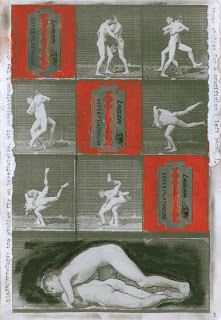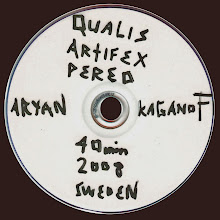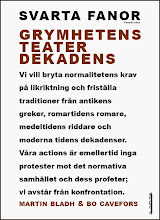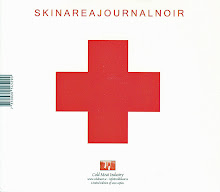4.9.12
DES : I'll be the Mirror...
DES : I'll be the Mirror - extract (2012)
This interview with Shane Levene was conducted by Martin Bladh
21.5.10
Bo I. Cavefors : DIE TOTENINSEL / THE ISLAND OF DEATH

Wie froh bin ich,
22.8.08
Bad Alchemy #59/08 : MARTIN BLADH

Bad Alchemy #59/08
Rigo Dittmann:
MARTIN BLADH
Martin Bladh: Bacon - Heliogabalus - de Rais
Es fing alles harmlos an, mit einer dieser Musiken von der traurigen Gestalt, die auf der müde gewordenen Industrial-Rosinante gegen Schafe wüten. Aber Don Quichote und Sisyphos zählen nun mal zu meinen wenigen Helden. Seit etwa zehn Jahren huldigen Martin Bladh, zuständig für Gesang und Artwork, und Erik Jarl, der bei IRM für den Krach sorgt, in Norrköping etwas, was ihnen als Ästhetik der Schreckens noch nicht ausgereizt scheint. Titel wie An Act Of Self Mutilation Is An Act Of Freedom oder ‚Sebastian‘ (auf The Cult Of The Young Men) lassen mich vermuten, dass ich an der postindustrialen S/M-Front keine neuen Entwicklungen versäumt habe.
IRM hat sich für Indications of Nigredo (Seger 23, 12") mit dem Bassisten Mikael Oretoft verstärkt, der Jarls Knurschelektronik mit dunklen Twangs durchsetzt. Vor dieser sich langsam aufbauenen Wall of Sound wirken Bladhs Einwürfe seltsam dünn u nd wie kastriert. Der grusig harsche Noise kommt als gnadenloses Mahlwerk ins Rollen, die Stimme klingt immer gequälter und panischer. Wieder gefasst, stellt sich Bladh einem zweiten Härtetest und verliest die Versuchsanordnung. Dann überdröhnt und umflattert ihn ‚Indicator 2‘, ein Sturm aus Noise und Eis, unter dessen Pfeilhagel er sich als Hl. Sebastian windet. Beatkaskaden und zeitlupiges Bassgedröhn geben der Inszenierung einen rituellen Anstrich. Bladh schreit wie am Spieß Parolen, um anschließend seine Wunden zu lecken. Ist der wirkliche Name des jungen Mannes Narziss? Oder Marsyas?
nd wie kastriert. Der grusig harsche Noise kommt als gnadenloses Mahlwerk ins Rollen, die Stimme klingt immer gequälter und panischer. Wieder gefasst, stellt sich Bladh einem zweiten Härtetest und verliest die Versuchsanordnung. Dann überdröhnt und umflattert ihn ‚Indicator 2‘, ein Sturm aus Noise und Eis, unter dessen Pfeilhagel er sich als Hl. Sebastian windet. Beatkaskaden und zeitlupiges Bassgedröhn geben der Inszenierung einen rituellen Anstrich. Bladh schreit wie am Spieß Parolen, um anschließend seine Wunden zu lecken. Ist der wirkliche Name des jungen Mannes Narziss? Oder Marsyas?
Beim Versuch, mir ein Bild zu machen, stieß ich auf Bladhs Werkstudien zu Francis Bacon, Heliogabalus und Gilles de Rais, mit denen er Performances von Bo Cavefors‘ Teater Dekadens visualisierte (eingefangen auf M. Bladh & Bo I Cavefors Three studies for a crucifixion, Firework Edition Records, FEV1008/FER1070, DVD + CD, die wie bestellt in meinem Briefkasten landete). Die Kollaboration geht einher mit einem Manifest, das ein ‚Neues Theater der Grausamkeit‘ ankündigt (nachzulesen auf http://sadojapan.blogspot.com/). Zwischen dionysischer Verschwendung und der Desinvoltura von Ernst Jüngers ‚Anarchen‘ wird das Ungenormte und das ‚Agere Contra‘ gefeiert. Ernst Jünger? Mein Interesse wuchs. Die Musik, die Bladh & Jarl zum ‚Passionsspiel‘ über Francis Bacon und dessen morbider Faszination durch Schlachtvieh und Verkehrsopfer generierten, ist anfänglich ruhig, nur ein gebändigter Orgeldrone, kristallin übersprenkelt. Cavefors liest dazu, The Miracle‘, ein Lehrstück über einen frechen Straßenköter, der gesteinigt wird, Anfang einer Kette von Selektionen, mit denen die Anständigen und Braven sich von Parasiten, Störenfrieden, Aussätzigen und Bastarden säubern. Der Drone durchbohrt auch den langen Mittelteil der Three Studies for a Crucification, lange nur monoton, dann zunehmend hochtourig wie eine Turbine. Vereinzelt erklingen metallische Schläge, die sich zu einem schweren Dingdong einpendeln, während die Maschine spitze Obertöne sirrt.
Der dritte Teil besteht in hellerem Sirrklang und wieder silbrigem Geriesel, Cavefors liest nun, wieder paradox nüchtern und unpathetisch, ‚Revolt in the Kasbah‘, einen Text, der die Parias und ‚Wild Boys‘ aller Länder zu Orgie und Exzess unter der Schwarzen Fahne und dem Banner de Sades aufruft und dazu, der Gesellschaft den Rücken zu kehren. Danach schwillt der Noise an zu einem finalen Elektronensturm, durchschrillt von wild gewordenen Dudelsäcken und hyperventilierenden Furien.
Es war an der Zeit, mit dem Künstler selber Kontakt aufzunehmen und einige Aspekte des Faszinosums zu beleuchten. Martin Bladh hat auf meine Fragen am 30.6.2008 geantwortet.
BA: Your work is a unity of sound, lyrics, vision & body (Vienna Actionism, Theatre of Orgies and Mysteries). Are You seeking for a synthesis of art & life, or how are Your talents and passions related?
MB: To me it is absolutely necessary that art and life frequently overlap each other. If you’re passionate about something you carry it with you 24 hours a day. I think it’s very important for artists to dare to be pretentious; you can’t make art as a hobby or a nine to five work. Then I wouldn’t go that far as to state, like several silly Fluxus-artists have done, that drinking a cup of coffee or blow air into a balloon is art and thereby important. It’s always a hard and exhaustive struggle for an artist to look for and settle on his chosen medium. Only because you’re a good draughtsman doesn’t necessary make you a good artist. Music was my first artistic outlet, but after a couple of years it seemed futile for several of the ideas I nurtured. I then turned to painting, writing, performance etc. and still I haven’t been able to restrict myself to one media. So, yes I’m interested in a work that spans over several different mediums and thereby works as a synthesis on different levels and senses. I guess Wagner and Nitsch have helped me to legitimise this whole idea of the Gesamtkunstwerk. This way of working is very important to me, and has helped me enormously when I’ve tried to pin down my obsessions and special interests.
BA: If You had to go back in time for a ‘Self-portrait of M. B. as a young monkey’ (to steal from another M. B., Michel Butor), when and how did it dawn on You that You are… different, maudit, an - artist?
MB: When I passed on from being a mere listener and observer to being creative. At a certain point (probably by the beginning of the millennium) I decided that I didn’t want to dedicate my life to someone else’s work. Certainly, after IRM had recorded Oedipus Dethroned [2000], I thought that I had something going that I wanted to dig deeper into and would take years to exhaust. A couple of years later when I first saw my own vision materialised in the flesh, I got quite exited cause this was an image I’ve been thinking of for years. The action work Sensation is Everything was of great importance to me (although I don’t fashion it as one of my better pieces today).
Mit Bo I. Cavefors (*1935) begegnet einem jemand, der vom Enfant terrible bis zum‚ unwürdigen Greis’ eine gradlinige Biographie des Verfemten vorgelebt hat. Ob als Verleger, Autobiograph oder Essayist, mit Cavefors hat das Heterogene eine erste Adresse in Lund. In den 60er-80er Jahren hatte er unermüdlich anarchische, anrüchige, pataphysische, psychoanalytische und revolutionäre Literatur publiziert (Burroughs, Dali, Jünger, Lautréamont, Mao, Nietzsche, Pasolini, Pound, A. & P. Weiss…), bis der Skandal um RAFTexte
zum Bankrott und Schweizer Exil des Verlags führte. Seit den 90ern sorgt er für Skandal mit seiner Textreihe Svarta Fanor, ein Name, in dem neben der Drapeau Noir der Anarchie auch Strindbergs Schwarze Fahnen mitschwingen, und mit dem Teater Dekadens, das Nitschs Mysterientheater abwandelt zu Exerzitien des Verfemten. Ich sage bewusst ‚Exerzitien’, denn Ignatius von Loyola ist mit seinem ‚Agere Contra’ ein unwahrscheinlicher, aber wesentlicher Stichwortgeber für Cavefors ‚politische Theologie’.
Cavefors‘ ‚unmöglicher’ Horizont, für den man sich hierzulande eine Fusion aus März Verlag und Matthes & Seitz vorstellen müsste, verbindet Ideen der Konservativen Revolution und des Heroischen Nihilismus mit der Spiritualität der Kartäuser und erotischer Verausgabung. Ernst Jüngers ‚Anarch’ (aus Der Waldgang) ist der Heros einer Souveränität, die Carl Schmitts diktatorische Definition ‚Souverän ist, wer über den Ausnahmezustand entscheidet’ (d. h. wer den Notstand ausrufen und mit Polizei und Militär jeden Widerstand platt machen kann) mit Bataille’schen Vorzeichen anarchisch umkehrt: Souverän ist, wer gegen die Normierungsgewalten um jeden Preis seinen persönlichen Ausnahmezustand lebt.
BA: The emphasis on excess and enjoyment at any cost, what You call ‘sexual absolutism’, and the motto: Agere contra (to act against) seem to contradict the ‘desinvoltura’ of Ernst Jünger’s ‘Anark’, another heroic model of Yours, whose attitude is to resist power by ignoring it?
MB: My work is full of contradictions. But I cannot really see the contradiction between the Jüngerian Anark and the supreme libertine. Although I respect Jünger’s work I can’t really say he’s been that influential on my part, the manifesto was written in collaboration with Bo Cavefors. I myself have nurtured a project which I used to call The New Theatre of Cruelty and Bo got his own project called Theatre Decadence. Bo is a huge admirer of Jünger and he was one of the first to introduce his work to the Swedish audience in the sixties. The main reason for quoting him was to illustrate how we don’t care about the political movements of today, and thus through our theatre feel ourselves liberated from them. As stated our agere contra is a very personal one and has nothing to do with a collective utopian following, it has to do with being aware of the world, but ignoring it and thereby act against it; to live inside a society but at the same time be able to live outside of it. I don’t see this as a heroic act but a necessary one. Communication is what it is, and foremost directly related to our own carnal desire, exhibitionism and narcissism, masochism and sadism.
Martin Bladh (*1976) macht als Maler und „‚bad boy’ of Swedish performance art" den Exzess des Ausnahmezustands sichtbar. Die Klinge, die in seinem Namen aufblitzt, nimmt es als Skalpell, um Körper zu vivisezieren, um Blut fließen zu lassen, um zu kastrieren oder gar den Kopf zu amputieren. Das Wort wird Fleisch, das sich selbst in einem Kult der Acéphalie einem kopflosen Gott opfert, oder dem Dionysos zagreus, dem zerrissenen Gott. Oder sich einem obszön-idiotischen ‚Genießen’ (Jouissance) hingibt? Versucht hier Kunst durch Blut und Schmerz wieder etwas Sakrales zu kommunizieren? Lässt sich Unmittelbarkeit (zu einer ‚göttlichen’ Wahrheit oder Wirklichkeit hinter dem Buchstaben und Bildern?) wiedergewinnen, wenn man seine Unversehrtheit preisgibt und ‚außer sich’ gerät
BA: Many of Your motifs (like Isaac, Oedipus, Jesus, Sebastian, de Rais, Jack the Ripper…) are about violence in a sado-masochistic vexation of offender and victim, of the sacred & the infame. How does this recurrence of the body as battleground of pain & lust relate to our more and more virtual and abstract times?
MB: Discourses such as sex and violence are of great importance to me. And all the names you mentioned are more or less archetypical examples of these discourses combined. They are icons, some of them considered holy, some infamous, but I also think that all of them have a pornographic quality which I
find to be very seductive. And this is very obvious, when looking at how they’re depicted in today’s media and arts. These "characters" and there tragic or heroic destinies are also important as mirror images which I can superimpose onto myself, as both the victim and aggressor. I’m not making a political statement on art or media, my work is all about me, my taste and obsessions.
BA: Am I wrong, or is there also an oxymoronic mixture, or undissolved tension of ‘hot’/organic/red (flesh, blood, cry) vs. ‘cold’/anorganic/black (machine noise, skull, razorblade) in Your work?
MB: You’re absolutely right. The paradoxical marriage between life and death fascinates me enormously. I wouldn’t take it as far as to say that I try to illustrate the Freudian death drive versus the pleasure principle struggle, but this kind of contradiction is very dear to me; the aggressive sex drive and the programmed inner yearning for an inorganic state. The relation between love and hate, masochism and sadism, the cold razor and the warm flesh. A piece is only successful if it got the power to unnerve me and seduce me at the same time.
Wird man nur in der konsequenten Imitatio Christi auf der Schlachtbank oder am Kreuz selbst zum Gotteskind? Geht es – nur anders gesagt - um alchemistische Transmutation - nigredo(Schwärzung) – albedo (Weißung) – rubedo (Rötung) - , durch den Sonnen-Anus (Sol niger) zur Reinigung der Seele von ihren leprösen Schwefelanteilen, zur Erleuchtung und Vereinigung mit dem Unbegrenzten? Statt einer unmöglichen Subversion Perversion, statt einer Transmutation der Welt die Transmutation des Einzelnen?
BA: An IRM album is called Indications of Nigredo, and there seem to be alchemical motifs in the Heliogabalus cycle too. Or rather motifs of the Apocalypse, when even kings and bishops will be fodder for swine and wolves?
MB: First of all, I’m not a religious man. I’ve used esoterica in a metaphorical way, somewhat in the same way as Jung, and to point out contradictions; the marriage of the opposites etc. Although, religious and mythical themes tend to
fascinate me, and especially the alchemical state of Nigredo has been influential. The "apocalyptic" illustrations from the Heliogabalus cycle are referring
to the bodyguards‘ dismembering of the queer emperor.
Oder geht es um einen (männlichen) Geburtsakt, durch Kaiserschnitt oder einen Schnitt, der die Nabelschnur zum jämmerlich Irdischen durchtrennt? Bladhs erstes Soloalbum Umbilical Cords (Segerhuva, 2005), auf dt. ‚Nabelschnüre’, ist eine Phantasie über das Hineingeborenwerden in den ‚lebendigen Tod’ (Artaud). Kunst gibt sich als neue Gnosis weltverächtlich, als Abführmittel, als ‚Purgatorium der Sinne’ (R. Schwarzkogler). Man hört ungut schleifende, grollende Mäander, Bass und Cymbals gestrichen, untergründig leicht melodiös, aber nach Außen hin eine schlecht geölte Dröhnmaschine, und gegen Ende, von einer Gitarre monoton beschrammelt, den verhuschten Singsang: The body is a screamer. Was er wohl schreit, so erfüllt vom Geist der Schwere und der Bitterkeit? Aus der Tiefe zu dir rufen wir bedrängte Kinder dein? Von was will diese Kunst reinigen? Vom Geist? Von der Bitterkeit? Von der Restsüße, die uns sinnlich fesselt? Was will da oder will da nicht ans Licht?
BA: The ‘part maudit’, the ‘accursed share’ in Your work seems to be the (male) body, often as a split cadavre, more often headless (acephalos), or mutilated / castrated. Is the body and especially the Male Sex part of the problem, or part of a solution?
MB: I don’t see it neither as a problem or a solution. It’s matter of personal taste and obsession, in the end everything comes down to the human flesh, it’s all that matters. A work of art has to be centred round the body to hold any real interest to me at all, and often so, the mutilated male body (my own or a stranger‘s). What I seek and what I’m trying to manifest (on paper or in the flesh) is a personal depiction of sensation, a strong sensual and aesthetic form of exaltation. The headless body is foremost a way to get rid of the obvious connection to my own person, to make the work more vague and suggestive: an anonymous flesh. The wounded genitals are the most obvious and symbolical way to impersonate the crippled and futile body, and what a wonderful seductive picture it is.
Was machen die ‚Three Studies for a Cruzification’, ‚Dead Ringer 2’ oder ‚Matt. 5:29-30’ aus dem Betrachter? Fromme Meditierer eines erlösenden Mysteriums? Voyeure eines Spektakels, an dem sich die Lüstern-Faszinierten von den Angeekelt-Faszinierten und Täter-(empowerment) von Opferidentifikation (victimisation) scheiden? Im Gegensatz zu Carl Abrahamsson halte ich es für wahrscheinlicher, dass gerade auch die Geduckten und Ängstlichen aufs Mattäusevangeliums pfeifen (Wenn dich dein rechtes Auge zum Bösen verführt, dann reiß es aus und wirf es weg!) und lieber abgebrüht glotzen, als in die Haut des Gepeinigten zu schlüpfen. Dass man sich mit der Grausamkeit statt dem Leiden solidarisiert (R. Rorty), ist für die ‚Ich-bin-doch-nicht-blöd’-Mehrheit mit Rückenwind durch das Mehr-Gags-mehr-Sex-mehr-Gewalt-Postulat keine Frage, Opfer sind blöd, sind etwas, auf das man tritt und spuckt, Hannibal Lector und Jigsaw dagegen Kult. Bladh gibt dem Opfer, dem Kadaver, wieder eine Aura des Heiligen, auch wenn, wie bei Bacon, die Kreuze vor einem gottlosen Horizont stehen.
BA: There is always the human weakness to identify with the aggressor or the aggressive, which makes Industrial, Harsh Noise or Black Metal etc. so attractive as camouflage for sissies. What is Your artistic angle in this dilemma?
MB: I’ve never been interested in provocation, or breaking taboos just for the sake of it. The people you’re referring to use these "extreme" subject matters as a legal and safe outlet for inner urges and fantasies which they don’t dare to step further into. They never go beyond a certain point, and that in the end makes their work futile and uninteresting. I don’t think I ever ventured into this small minded "sadistic" area myself; I’m equally interested in the victim’s role as the executioner’s.
BA: As poet & voice of IRM You are delivering Your heart on Your tongue. Articulating phobias, spitting words about martyrium & katharsis, suffering & self-mutilation, about an unnamed desease or wound. On Four Studies for Crucification (2002) You called the desease ‘time infection’. Is it mortality itself?
MB: Yes in this case I think your remark is accurate. The disease might be seen as life itself, the human body; this great exhilarating and obnoxious disease. At the moment I’m involved in a collaborative project with Swedish artist Stefan Danielsson, in which I rework old IRM lyrics and present them along side his beautiful collages. It will be very interesting to see someone else animate these words. And the lyrics for the piece you mentioned were actually used as a starting point for this project.
BA: Your paintings are like illustrations to A. Artaud’s >Heliogabalus: Or, the Crowned Anarchist<, or to Georges Bataille. But if asked to illustrate something unexpected, what would You choose to visualize? MB: The series of collage paintings, or work studies as I call them myself, all deal with specific subject matters and illustrate the three dramas Three Studies for a Crucifixion; Heliogabalus and Gilles de Rais which I’ve written as a collaboration with Cavefors. I recently did some single illustrations for Huysmans En Rade [1887, dt. Auf Reede] and Hermann Ungar’s The Maimed [Die Verstümmelten, 1923] on demand for a Swedish publication. But I would never illustrate a work that doesn’t hold any interest to me.
+ + + + +
Bad Alchemy Magazine
#59/08
Hmmm Dämon - Bidner & Martinek, Meese & Feuerstein (Dämonologische und ludologische Überlegungen); Martin Bladhs Theater der Grausamkeit; Joyful Noise - Taktlos 2008 (von GZ); 25 Jahre 'Musique Action' (von Bernd Weber); Party Intellectuals - Ceramic Dog live; A Potent Brew - Sean Noonan's Brewed By Noon; If You Like Armaggedon - Evangelista (von M. Beck); Veins to the Sky - Alexander Tucker; The Spectres of lost Possibilities - Hauntologische Splitter; Konfrontationen Nickelsdorf 2008 (von R. Gmöhling); Das Pop-Analphabet von Allroh bis Z'ev [nur für Abonnenten: Artwork von MARTIN BLADH]
Bad Alchemy erscheint ca. 2–3 mal jährlich.
Herausgeber: Rigo Dittmann
25.9.07
EXHIBITION : MARTIN BLADH
GALLERY BO CAVEFORS and THE NEW CRUELTY THEATRE DECADENCE present the work studies by MARTIN BLADH for 3 actions, Francis Bacon, Heliogabalus, Gilles de Rais.
THE NEW THEATRE OF CRUELTY has a constant discourse with the universal theme violence-sex-death-cruelty, and THEATRE DECADENCE expose the possibilities of agere contra as an answer of the norm-terrorism. agere contra: break off the foundationalism of uniformity and release the traditions from the ancient Greeks, from Romans of the Roman Empire, from the equestrians of Middle Ages and from the decadency of to-day. Non-norms are, that’s our belief, the normal-reality and the norms are the real morbid, hokey, obtruded, the non-worthy. Howe’er, our actions are no and never outcries against the norm-society and it’s seers; we waive face-downs. We have no political declarations. We manifest how the abasement can be handled when we convert it to enjoyment and sexual absolutism and exhibitionism and a strict acceptation of it’s most profounded consequences, sperm, blood, whips.
Our first action/performance, related to Francis Bacon, Three Studies for a crucifixion, is followed by actions about the Roman paederast Heliogabalus and Gilles de Rais, the mediavel-boylover, the virtiuoso and aesthetican. An eon of twothousand years shall be visualized: how rites and Eucharistic adoration are transfigured in the flight of time, but still are ageless: Dionysiac indulgence, body and sex, distress, the surrender, blood and hangmen.
Ernst Jünger mention the “anark”, the man who smash the power in ignoring it, an individual resigning the normal. That’s our position. As Jean Genet said: “If our theatre stink it’s because all other plays stink good”.
Martin Bladh / Bo I. Cavefors













































